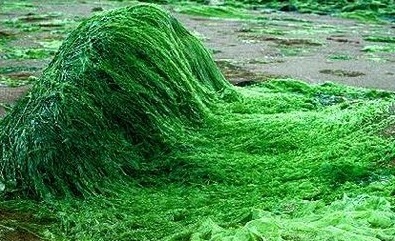
Blog Contents
Question
One of our readers just asked if she should use up the packet of spirulina that has been lingering in her larder for some months.
Simple answer: No. Bin it!
What is spirulina?
Spirulina, referred to as a blue-green algae, belongs to the family of several species of micro algae such as blue-green aphanizomenon (the closest relative of Spirulina) and green algae chlorella and dunaliella. The dried biomass of spirulina is called Arthrospira platensis, and it belongs to the oxygenic photosynthetic bacteria that cover the groups Cyanobacteria and Prochlorales.
Where is it found?
Spirulina can be found on every continent and grows naturally in mineral-rich alkaline lakes.
Is it good for you?
In its pure non-polluted state, for instance, when the Mexican Aztecs were harvesting it from algae in Lake Texcoco back in the 1400-1600’s, it may have fulfilled some of the health benefits claim today, in terms of lowering blood pressure and cholesterol levels and treating seasonal allergies. But, and it’s a big BUT, there is a real and dangerous issue surrounding its use in the 21st Century.
What’s the problem?
There are serious concerns (1., 2.) about the levels of toxins contained in those spirulina supplements you see in your local health store. 94% of samples taken in one study contained other algae and were contaminated with hepatotoxic microcystin toxins, along with dangerous levels of another potent neurotoxin. Additionally, cyanobacteria blooms in lakes are increasing and they can contaminate the specific algae, spirulina, used in supplements. The health risks of all this can include: seizures in infants (3.), muscle breakdown, liver cancer, and liver toxicity (4.).
But we are told it’s safe…
Yes, it’s true that spirulina was evaluated by the USP (The United States Pharmacopeia) and they found that “..the available evidence does not indicate a serious risk to health or other public health concern when spirulina is properly identified, formulated, and used.” (5.) But that’s the problem – other algae (the dangerous stuff) can often be mixed in with the spirulina because it is often grown in and collected from open lakes where various blue-green algae grow and mix together. So, unless you are 100% certain that the spirulina you have has been rigorously tested and passed as spirulina – the whole spirulina, and nothing but the spirulina – give it a wide berth.
Why bother anyway?
Look, even accepting that 100% pure spirulina has health benefits, if you are really worried about lowering your blood pressure and cholesterol while also improving your autoimmune system, all you have to do is follow a balanced whole food plant-based diet with lots of exercise, get lots of sleep and avoid unnecessary stress.
There’s always loads of money for Big Pharma to make out of selling you “health in a bottle”; so no wonder they are not interested in people getting healthy by ignoring their often highly-priced products and simply eating healthy food as it was meant to be eaten.
References
- Y. Jiang, P. Xie, J. Chen, and G. Liang. Detection of the hepatotoxic microcystins in 36 kinds of cyanobacteria Spirulina food products in China. Food Addit Contam Part A Chem Anal Control Expo Risk Assess, 25(7):885-894, 2008.
- Rellán S, Osswald J, Saker M, Gago-Martinez A, Vasconcelos V. Food Chem Toxicol. 2009 Sep;47(9):2189-95. Epub 2009 Jun 9. First detection of anatoxin-a in human and animal dietary supplements containing cyanobacteria.
- Moulis G, Batz A, Durrieu G, Viard C, Decramer S, Montastruc JL. Eur J Clin Pharmacol. 2012 Feb;68(2):221-2. doi: 10.1007/s00228-011-1113-5. Epub 2011 Aug 13. Severe neonatal hypercalcemia related to maternal exposure to nutritional supplement containing Spirulina.
- Zhang F1, Lee J2,3,4, Liang S5,6, Shum CK7,8. Environ Health.2015 May 7;14:41. doi: 10.1186/s12940-015-0026-7. Cyanobacteria blooms and non-alcoholic liver disease: evidence from a county level ecological study in the United States.
- Marles RJ1, Barrett ML, Barnes J, Chavez ML, Gardiner P, Ko R, Mahady GB, Low Dog T, Sarma ND, Giancaspro GI, Sharaf M, Griffiths J. Crit Rev Food Sci Nutr. 2011 Aug;51(7):593-604. doi: 10.1080/10408391003721719. United States pharmacopeia safety evaluation of spirulina.
Finally, if you want to hear from Dr Michael Greger on this subject, have a look at these spirulina videos:
[youtube https://www.youtube.com/watch?v=74bbWmFhLzk&w=1150&h=647][youtube https://www.youtube.com/watch?v=gk4O232TVeE&w=1150&h=647][youtube https://www.youtube.com/watch?v=GEInBCJPtGQ&w=1150&h=647]